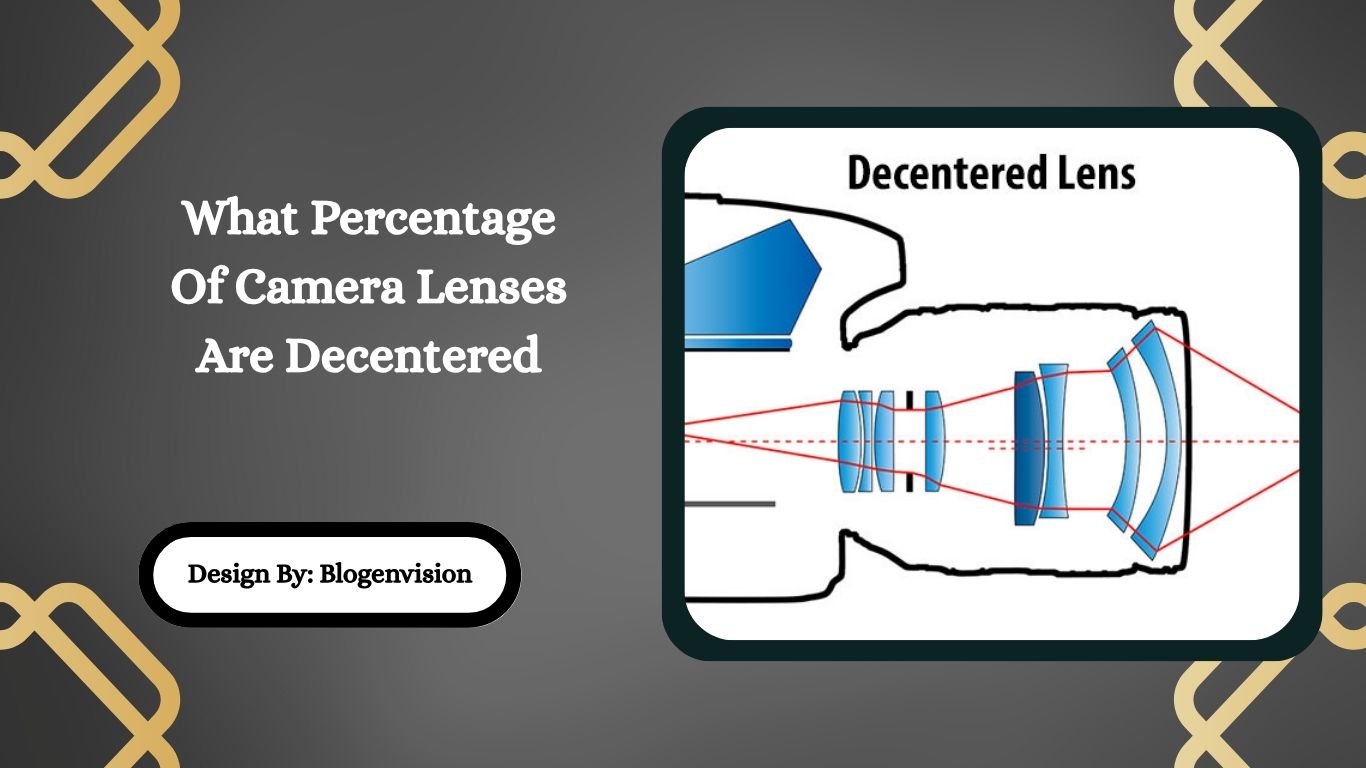What Percentage Of Camera Lenses Are Decentered – Closer Look at Lens!
Approximately 5–10% of camera lenses are decentered, affecting image sharpness. This issue arises from manufacturing errors, impact damage, or poor assembly, and it’s more common in zoom and budget lenses.
When investing in camera gear, photographers expect sharp, consistent image quality. However, one often overlooked issue that can affect even high-end lenses is decentering. If you’ve ever noticed that one side of your image is softer than the other, a decentered lens might be the culprit. But just how common is this problem?
In this article, we’ll explore what lens decentering is, what percentage of camera lenses are affected, how to detect it, and what you can do about it.
What Is Lens Decentering?
Lens decentering occurs when one or more lens elements inside the lens barrel are not perfectly aligned along the optical axis. This misalignment can lead to image quality issues such as:
- Blurry edges or corners
- Uneven sharpness across the frame
- Reduced contrast or sharpness on one side
It’s a manufacturing defect or damage from impact, and it can be subtle or severe depending on the degree of misalignment.
What Percentage of Camera Lenses Are Decentered?

There are no official statistics released by lens manufacturers, but based on data from photographers, repair technicians, and independent testing labs, approximately 5% to 10% of consumer lenses show some level of decentering out of the box.
Breakdown:
- Mild decentering: Around 5–7% of lenses may exhibit slight decentering, often within acceptable quality control tolerances.
- Severe decentering: Around 1–3% of lenses are significantly decentered, enough to noticeably degrade image quality.
These numbers can vary by brand, lens model, and manufacturing standards. Higher-end lenses typically go through more rigorous testing, but even premium models are not immune.
Why Does Decentering Happen?
Decentering can occur due to various reasons during or after the manufacturing process:
- Manufacturing Tolerances: Lens production involves assembling multiple glass elements with extreme precision. Even a small deviation in microns can affect optical alignment.
- Transport Damage: Lenses can become decentered during shipping or due to handling before they reach the consumer.
- User Impact or Drop: Dropping or bumping your lens can knock elements out of alignment, especially if it’s not weather-sealed or built with rugged housing.
- Internal Component Shifts Over Time: Even if not physically damaged, mechanical stress or poor design can allow components to shift over time, especially in zoom lenses.
How to Test Your Lens for Decentering?
You don’t need lab equipment to check for decentering. Here’s a simple test you can perform at home:
Step-by-Step Guide:
- Mount your camera on a tripod.
- Use a flat, detailed subject like a brick wall, bookcase, or printed test chart.
- Shoot at the widest aperture (e.g., f/2.8 or wider).
- Use center focus and compare corners by zooming into the photo at 100%.
What to Look For?
- One corner is softer than the others
- Edges show uneven blur or distortion
- Shifted or uneven chromatic aberration
If the blur is only on one side or in one corner and consistent across multiple shots, your lens may be decentered.
Which Lenses Are More Prone to Decentering?
Certain types of lenses are more susceptible due to design complexity and quality control variability.
- Zoom Lenses: Zooms have more moving parts, so alignment is harder to maintain. Mid-range consumer zooms are especially prone.
- Fast Prime Lenses: Lenses with wide maximum apertures (e.g., f/1.4 or f/1.2) are more sensitive to misalignment due to the shallow depth of field and critical optics.
- Third-Party Lenses: Some third-party brands may have looser quality control than OEMs like Canon, Nikon, or Sony though many have improved in recent years.
- Budget Kit Lenses: Cheaper lenses often use more plastic and have simpler quality control processes, increasing the chance of decentering.
What Should You Do If Your Lens Is Decentered?
If you suspect your lens is decentered, here are your options:
- Check Warranty and Return Policy: If the lens is new, return or exchange it immediately. Most retailers have a 15–30 day return window.
- Send It for Professional Calibration: Some manufacturers offer lens calibration or adjustment services. Costs vary but are typically $100–$200.
- Use the Lens Within Its Limits: If the decentering is mild, stopping down the aperture (to f/5.6–f/8) may minimize the impact for general photography.
- Avoid Buying Used Without Testing: If buying a used lens, always test for decentering before committing to the purchase.
Can Decentering Be Fixed?

Yes, professional repair centers can re-align lens elements. However, it’s not always economically viable unless the lens is high-end or under warranty. Repair involves:
- Disassembling the lens
- Adjusting or re-centering optical elements
- Re-testing sharpness and alignment
For older or budget lenses, replacement may be a better option than repair.
How to Minimize Your Risk When Buying Lenses?
Here are a few practical tips:
- Buy from reputable dealers who offer return policies.
- Test your lens immediately after purchase using the methods above.
- Avoid grey-market lenses, which may not come with warranty support.
- Check online reviews or forums for decentering reports on specific lens models.
- Consider refurbished lenses from the manufacturer, which are often retested for quality.
FAQs:
1. What is lens decentering in photography?
Lens decentering occurs when optical elements inside a lens are misaligned, leading to uneven sharpness, blurry corners, or one-sided softness in images, especially at wide apertures.
2. How can I check if my lens is decentered?
Mount your camera on a tripod, photograph a flat subject like a wall, and compare sharpness across the frame. Inconsistent blur or soft corners can indicate decentering.
3. Is lens decentering repairable?
Yes, professional technicians can realign decentered lenses, but repairs can be costly. For budget lenses, it may be more practical to replace rather than repair.
4. Are prime lenses less likely to be decentered than zoom lenses?
Yes, prime lenses have simpler optical designs, making them less prone to decentering than zoom lenses, which contain more moving parts and complex element arrangements.
5. Should I return a decentered lens even if the issue is minor?
If within return or warranty period, it’s best to exchange or repair the lens. Even minor decentering can affect image quality, especially in professional or critical work.
Conclusion:
Lens decentering is a subtle but impactful issue that affects around 5–10% of lenses, often going unnoticed until image quality suffers. It’s more common in zoom and budget lenses due to complex design and loose tolerances. Regular testing, careful handling, and buying from reputable sources can reduce your risk. If you detect decentering, address it promptly through returns or repair to ensure sharp, consistent performance from your gear.







